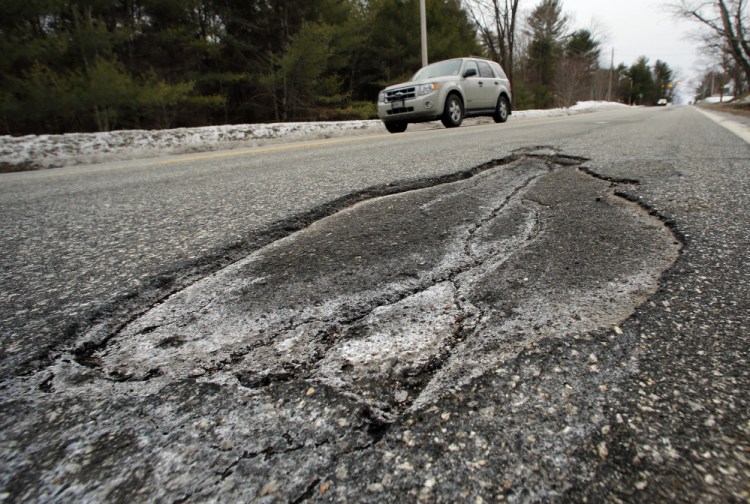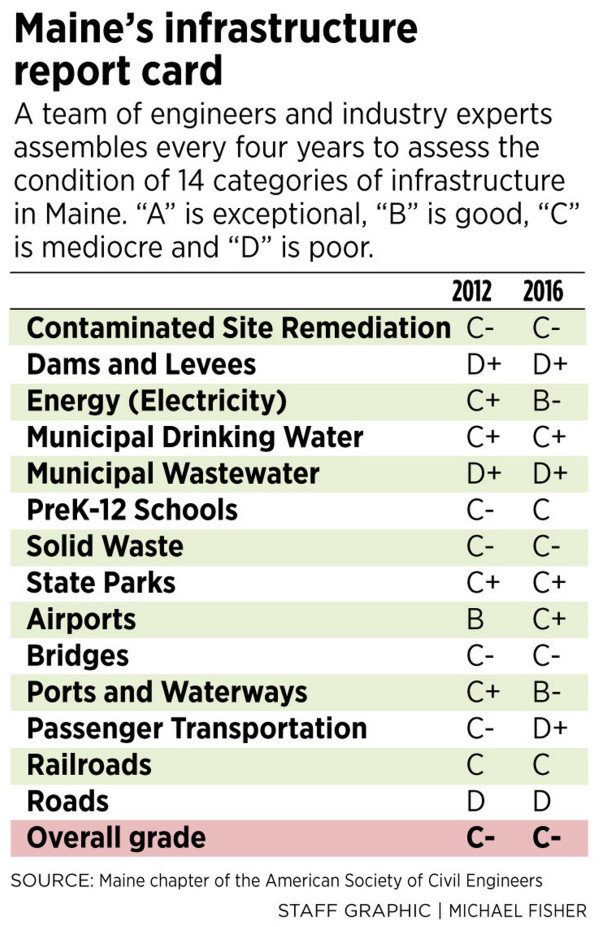The overall condition of the state’s infrastructure has not improved in the past four years and the condition of some facilities is declining, according to a report released Monday.
The 2016 report card, from the Maine chapter of the American Society of Civil Engineers, gives the state a C minus across 14 categories, including energy, roads, bridges, airports, schools, water systems and public transportation. It was the same grade the state received in 2012.
Whether President-elect Donald Trump’s plan to infuse billions into infrastructure upgrades across the country will actually happen is unknown, but the ASCE report paints a clear need. Maine ranked slightly above the national average of D plus, but below the C grades given to New Hampshire and Vermont. A and B grades mean exceptional and good, while a C grade is mediocre and D is poor and at-risk.
Eight of the categories have declining conditions in Maine since the 2012 report, and four – dams and levees, municipal waste water, roads and passenger transportation – are in poor condition, the ASCE said. Only two categories – ports and energy – were judged in good condition.
The report shows the same issues and recommendations highlighted by the ASCE since its first Maine report in 2008, said Lynn Farrington, president of the Maine chapter of the ASCE and traffic group manager at the Louis Berger Group, a global engineering firm.
“We now have 12 years of data, across those 12 years nothing is really changing,” she said.
It is not economically feasible to expect high grades across the board, but the ASCE draws attention to poor and deteriorating infrastructure, Farrington said.
Infrastructure projects in Maine are underfunded by tens of millions of dollars every year. The state’s roads receive the lowest funding per mile out of the six New England states and there is a projected $68 million annual funding gap, the ASCE said. Maine roads received a D in the 2016 report.
Wastewater systems, which received a D plus, need an estimated $1 billion in funding.
About 58 percent of the state’s 3,714 bridges are more than 50 years old, and the overall system received a C minus. Although there has been an increased emphasis on bridge replacement following a 2014 state report on bridge conditions, the state still needs an estimated $33 million more in annual funding, the report said.
“In most cases, government officials are doing exemplary work with the limited resources available,” Farrington said. “We are using the money we have effectively, we just need more.”
The decline in airports from B to C plus was a surprise since the Portland International Jetport completed a $160 million upgrade last year. The assessment team acknowledged that improvements have been made at airports around the state since the 2012 review, but noted that there have been no federal funding or fee increases since 2012. The report also noted that a lack of municipal money has contributed to a shortage of funds for aviation improvements.
PROMISES OF MORE FUNDING
If Trump keeps his campaign promises, increased funding might be around the corner. The president-elect said he would spend $550 billion on infrastructure over the next decade, double the amount proposed by opponent Hillary Clinton. An October white paper written by Trump advisers Peter Navarro and Wilbur Ross proposed $1 trillion in private funding for infrastructure, encouraged with $167 billion in tax credits. The authors of the paper argue the scheme is tax neutral because the government could collect revenue from wages and profits from the projects or give tax breaks to companies that repatriate money to the U.S. to invest in infrastructure.
Trump’s plan has been criticized as a giveaway for corporate interests by politicians on the left such as Sen. Bernie Sanders of Vermont and may meet opposition from congressional Republicans concerned about government spending and rising taxes.
Still, engineers are excited that infrastructure is getting a strong focus from the president-elect.
“We are definitely interested, $1 trillion is a good number for the next 10 years,” Farrington said. “There is a lot to be foreseen, what will actually happen and how much Maine will get, but we are optimistic.”
The Maine Department of Transportation faces an overall $75 million to $80 million budget shortfall every year, department spokesman Ted Talbot said. Most states are dealing with funding gaps, and although the nuts and bolts of Trump’s plan are sketchy, the fact that politicians are having conversations is encouraging, Talbot said.
“We don’t know any details, but they are talking,” Talbot said. “Everyone seems to be on the same page when it comes to infrastructure.”
Andrew McLean, D-Gorham, the Maine House chairman of the Legislature’s transportation committee, said he did not have an expectation for Trump’s plan and is wary of proposed public-private partnerships that could privatize services such as bridges and roads. Despite a $300 billion transportation bill passed by Congress last year, McLean said Maine should look for its own solutions instead of relying on increased federal aid.
“We have under-invested in our infrastructure for a long time,” McLean said. “I don’t think we should rely on Congress to find solutions soon, we have to look for them in Maine.”
Send questions/comments to the editors.





Success. Please wait for the page to reload. If the page does not reload within 5 seconds, please refresh the page.
Enter your email and password to access comments.
Hi, to comment on stories you must . This profile is in addition to your subscription and website login.
Already have a commenting profile? .
Invalid username/password.
Please check your email to confirm and complete your registration.
Only subscribers are eligible to post comments. Please subscribe or login first for digital access. Here’s why.
Use the form below to reset your password. When you've submitted your account email, we will send an email with a reset code.